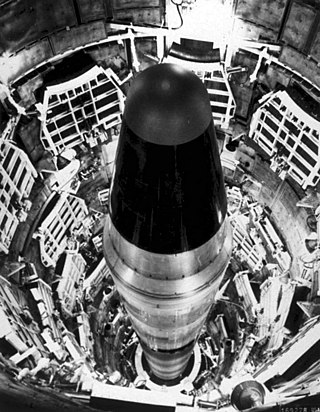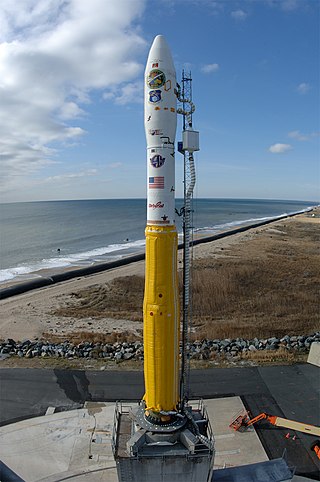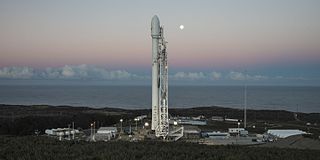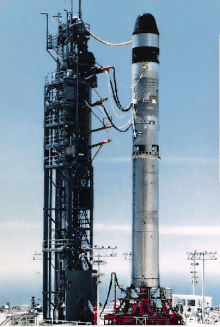
Titan was a family of United States expendable rockets used between 1959 and 2005. The Titan I and Titan II were part of the US Air Force's intercontinental ballistic missile (ICBM) fleet until 1987. The space launch vehicle versions contributed the majority of the 368 Titan launches, including all the Project Gemini crewed flights of the mid-1960s. Titan vehicles were also used to lift US military payloads as well as civilian agency reconnaissance satellites and to send interplanetary scientific probes throughout the Solar System.

Vandenberg Space Force Base, previously Vandenberg Air Force Base, is a United States Space Force Base in Santa Barbara County, California. Established in 1941, Vandenberg Space Force Base is a space launch base, launching spacecraft from the Western Range, and also performs missile testing. The United States Space Force's Space Launch Delta 30 serves as the host delta for the base. In addition to its military space launch mission, Vandenberg Space Force Base also hosts space launches for civil and commercial space entities, such as NASA and SpaceX.

test:https://en.m.wikipedia.org/wiki/1980_Damascus_Titan_missile_explosion

Titan IV was a family of heavy-lift space launch vehicles developed by Martin Marietta and operated by the United States Air Force from 1989 to 2005. Launches were conducted from Cape Canaveral Air Force Station, Florida and Vandenberg Air Force Base, California.

Titan IIIB was the collective name for a number of derivatives of the Titan II ICBM and Titan III launch vehicle, modified by the addition of an Agena upper stage. It consisted of four separate rockets. The Titan 23B was a basic Titan II with an Agena upper stage, and the Titan 24B was the same concept, but using the slightly enlarged Titan IIIM rocket as the base. The Titan 33B was a Titan 23B with the Agena enclosed in an enlarged fairing, in order to allow larger payloads to be launched. The final member of the Titan IIIB family was the Titan 34B which was a Titan 24B with the larger fairing used on the Titan 33B.

Minotaur-C, formerly known as Taurus or Taurus XL, is a four stage solid fueled launch vehicle built in the United States by Orbital Sciences and launched from SLC-576E at California's Vandenberg Air Force Base. It is based on the air-launched Pegasus rocket from the same manufacturer, utilizing a "zeroth stage" in place of an airplane. The Minotaur-C is able to carry a maximum payload of around 1458 kg into a low Earth orbit (LEO).

The Minotaur is a family of United States solid fuel launch vehicles derived from converted Minuteman and Peacekeeper intercontinental ballistic missiles (ICBM). They are built by Northrop Grumman via contract with the Space Force's Space Systems Command as part of the Space Force's Rocket Systems Launch Program (RSLP) which converts retired Intercontinental Ballistic Missiles into space and test launch systems for U.S. government agencies.

Space Launch Complex 6 at Vandenberg Space Force Base in California is a launch pad and support area. The site was originally developed starting in 1966, but no launches occurred until 1995, as it was repurposed sequentially for three programs that were subsequently cancelled. Initially to be used for Titan IIIM rockets and the Manned Orbiting Laboratory, these were cancelled before construction of SLC-6 was complete. The complex was later rebuilt to serve as the west coast launch site for the Space Shuttle, but went unused due to budget, safety and political considerations. The pad was subsequently used for four Athena rocket launches before being modified to support the Delta IV launch vehicle family, which used the pad for ten launches from 2006 until 2022. The last Delta IV launched in September 2022, and SpaceX leased SLC-6 in 2023 to convert it to launch Falcon 9 and Falcon Heavy starting in 2025.

Space Launch Complex 41 (SLC-41), previously Launch Complex 41 (LC-41), is an active launch site at Cape Canaveral Space Force Station. As of 2024, the site is used by United Launch Alliance (ULA) for Atlas V and Vulcan Centaur launches. Previously, it had been used by the USAF for Titan III and Titan IV launches.

The Minotaur I, or just Minotaur is an American expendable launch system derived from the Minuteman II missile. It is used to launch small satellites for the US Government, and is a member of the Minotaur family of rockets produced by Orbital Sciences Corporation.

The Thor-Burner was an American expendable launch system, a member of the Thor rocket family. It consisted of a Thor missile, with one or two Burner upper stages. It was used between 1965 and 1976 to orbit a number of satellites, most commonly Defense Meteorological Satellite Program (DMSP) weather satellites. Twenty-four were launched, of which two failed. It weighed 51,810 kg and was 24 metres tall.

The Titan 34D was a United States expendable launch vehicle used to launch a number of satellites for military applications.

Space Launch Complex 4 (SLC-4) is a launch and landing site at Vandenberg Space Force Base, California, U.S. It has two pads, both of which are used by SpaceX for Falcon 9, one for launch operations, and the other as Landing Zone 4 (LZ-4) for SpaceX landings.

Space Launch Complex 8 (SLC-8), is a launch pad at Vandenberg Space Force Base in California, United States. It is currently only used by Minotaur rockets. It was originally part of the California Spaceport and was known as the Commercial Launch Facility (CLF) or Space Launch Facility (SLF). In addition to supporting occasional Minotaur rockets, SLC-8 is capable of hosting small launch vehicles thanks to a new clean pad built in 2019; as of 2024, this has not been used. Much like the Minotaur rocket family itself, SLC-8 has seen little use since the early 2010s.
The SM-68 Titan was the designation of two intercontinental ballistic missiles developed for the United States Air Force. The Titan I and Titan II missiles were operational between 1962 and 1987 during the Cold War. These missiles, particularly the Titan II, were the basis of the Titan family of space launch vehicles.

The Titan II GLV or Gemini-Titan II was an American expendable launch system derived from the Titan II missile, which was used to launch twelve Gemini missions for NASA between 1964 and 1966. Two uncrewed launches followed by ten crewed ones were conducted from Launch Complex 19 at the Cape Canaveral Air Force Station, starting with Gemini 1 on April 8, 1964.

Minotaur II rockets consist of the M55A1 first stage and SR19AJ1 second stage of a decommissioned Minuteman missile. The third stage varies depending on the configuration required for the payload: a Minuteman II M57A1 stage is used on the baseline configuration, whilst the Minotaur II+ uses an SR-73-AJ. The Minotaur II Lite is a two-stage configuration, without a third stage. A heavy configuration is also available, with an Orion 50XL third stage, as used on the Minotaur I. The baseline configuration can propel a 400 kilograms (880 lb) payload 4,000 kilometres (2,500 mi) downrange, whilst the heavy configuration can place 1,400 kilograms (3,100 lb) onto an 8,000-kilometre (5,000 mi) trajectory.
The Minotaur III, also known as OSP-2 Target Launch Vehicle, Peacekeeper TLV, or OSP-2 TLV was an American rocket concept derived from the LGM-118 Peacekeeper missile. It was a member of the Minotaur family of rockets produced by Orbital Sciences Corporation and would have been used for long-range suborbital launches with heavy payloads. The Minotaur III was to be capable of launching 3,000 kilograms (6,600 lb) of payload 5,000 kilometres (3,100 mi) downrange. This role has been taken over by the near-identical Minotaur IV Lite and the lighter-lift Minotaur II.

The Athena I, known as the Lockheed Launch Vehicle (LLV) at the time of its first flight and Lockheed Martin Launch Vehicle (LMLV) at the time of its second flight, was an American small expendable launch system which was used for four launches between 1995 and 2001. It is a member of the Athena family of rockets, along with the larger Athena II.

The Athena II is an American small expendable launch system which was used for three launches between 1998 and 1999, and which was scheduled to return to service in 2012 but has not been flown again as of 2024. It is a member of the Athena family of rockets, along with the smaller Athena I.






























